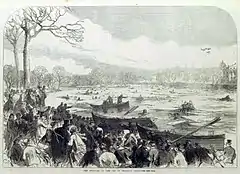Regent's Park skating disaster
The Regent's Park skating disaster occurred on 15 January 1867 when 40 people died after the ice broke on the lake in London's Regent's Park pitching about 200 people into icy water up to 12 ft (3.7 m) deep. Most were rescued by bystanders but 40 people died either from hypothermia or by drowning. The incident was considered at the time to be the worst weather-related accident in Britain. One of the consequences of the incident was that the lake bottom was raised and the overall depth of the lake reduced to a maximum depth of 4 ft (1.2 m), to help prevent adult drownings in the future.
 The incident as depicted by The Illustrated London News | |
| Date | 15 January 1867 |
|---|---|
| Location | Regent's Park, London, UK |
| Cause | Breaking ice |
| Deaths | 40 |
| Inquest | 21 January 1867 |
| Verdict | Accidental death in all cases |
Background
January 1867 was an exceptionally cold month in Britain and many open water areas froze over. One of these was the boating lake in Regent's Park in London, England. Ice skating was a popular pastime in Britain at the time, and many hundreds of people went skating on the lake, taking advantage of the frozen waters. On 14 January 1867, the ice cracked: 21 people dropped into the water but all were pulled out alive.[1]
Incident
Overnight, the ice refroze and the following day, about 500 people took to the ice with an estimated 2,000 more watching. At 3:30 pm the ice was heard to crack and almost half of the skaters fell into the water. As many could not swim and were wearing heavy clothing, they sank.[1] Those watching attempted to rescue them by launching boats and pulling branches from trees to use as lifelines.[2] Many were rescued unharmed, while survivors with hypothermia and recovered bodies were taken to the nearby Marylebone workhouse.[3] Recovery of all the bodies took several days as the lake kept refreezing and several bodies had to be removed from the bottom of the lake by divers.[4]
Inquest
An inquest was opened at the Marylebone workhouse on 16 January presided over by Edwin Lankester, the coroner for Central Middlesex, at which time 29 of the 34 bodies recovered had been identified.[5] The inquest resumed on 19 January to identify the remaining bodies and on 21 January the formal taking of evidence began.[6] Several witnesses were called and it emerged that, on the morning of the tragedy, workmen had been employed in breaking the ice around the islands on the lake to give wildfowl open water.[6] Other evidence given concurred with this but it was also pointed out that there had been no breaking of the ice at the shoreline.[6]
The jury returned their verdict in the afternoon of 21 January and, despite the evidence regarding intentional breaking of the ice, the verdicts were of accidental death in all 40 cases; 39 due to drowning and one due to hypothermia.[7]
Aftermath
The inquest jury also made a recommendation that the depth of the lake ought to be reduced; Lord John Manners, the First Commissioner of Works was in agreement and in June 1868 it was reported that the lake had been drained, the bottom levelled and lined with concrete and that the depth would be such that a "person of adult stature—might not be drowned".[8]
References
- "The legacy of a cold-weather disaster". The Times. 18 January 2017. Retrieved 16 January 2020.
- Brown, Paul (15 January 2012). "Weatherwatch: Ice-skating disaster that re-shaped Regent's Park lake". The Guardian. ISSN 0261-3077. Retrieved 16 January 2020.
- "Terrible Accident in Regent's Park. The Dangers of Skating". The Luton Times And Advertiser. XII (600). 19 January 1867. p. 4. Retrieved 17 January 2020 – via British Newspaper Archive.
- "The Catastrophe in Regent's Park". The Cheltenham Journal and Gloucestershire Gazette. XLIII (2221). 26 January 1867. p. 3. Retrieved 17 January 2020 – via British Newspaper Archive.
- "The Great Loss of Life at the Regent's Park". The Sun (23, 276). 16 January 1867. p. 7. Retrieved 17 January 2020 – via British Newspaper Archive.
- "The Ice Catastrophe in Regent's Park". Oxford Chronicle and Berks and Bucks Gazette (1, 557). 26 January 1867. p. 2. Retrieved 17 January 2020 – via British Newspaper Archive.
- "The Regent's Park Catastrophe. Inquest and Verdict of the Jury". Wrexham Advertiser. XIII (720). 2 February 1867. p. 8. Retrieved 17 January 2020 – via British Newspaper Archive.
- "The Regent's Park Lake". Illustrated London News. LII (1, 486). 6 June 1868. p. 17. Retrieved 17 January 2020 – via British Newspaper Archive.